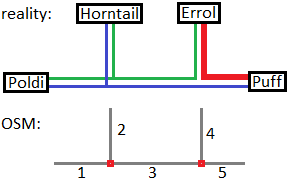Proposal:Power routing proposal/Tagging similar to Transportation routes
There are the two main point of view which had been expressed on OSM so far. The first one is in favor of type=route + route=power to map circuits since the power exchange is not so different of public transportation networks.
This scheme should be deprecated, so I removed it from the main proposal page and leave its description here for historical reason.
Tagging similar to Transportation routes
Thus power lines span across the country and electricity always take the shortes way it's transportation behavior is similar to a passenger in a bus. They can only travel at the offered routes (physical cable) and it's only possible to change the bus line at bus stops (distribution faccilities). One difference is there are three passengers (phases) which only can travel together (3 cables = 1 electric system) but hate eachother so much, nothing work when they connect (short circuit). ;-) So if 2 systems share the same power tower (6 cables are 2 systems) they have to reach the next power station to meet physicaly. ![]() Relations are a good way to show this in OSM. Put every
Relations are a good way to show this in OSM. Put every ![]() way and
way and ![]() power station connected with this system in one relation and tag as following example shows:
power station connected with this system in one relation and tag as following example shows:
- type=route
- route=power
- wires= (see wires=*)
- voltage=220000 (no point or colon)
- operator=XY Corp.
- cables= (see cables=*, mostly 3 or 6)
- frequency=50 (for 50 Hertz)
Simple example
| Nodes and ways in OSM reflect the physic infrastructure. But is this near enough on reality? Like many lanes of a road are only represented by one |
||
|
|
|
|
| Picture and key:value | Name in language | describtion en | Beschreibung de |
|---|---|---|---|
type=route route=power |
The route of a system from start to end can be shown with a relation. Like a bus route use streets (highway=*) power systems (=3 cables) using ways (power=line). But changing the line is only possible at stops (power=station)! So it is not possible to change your direction during traveling along the line. To represent these physical fact on a logical map you can use relations. Include all power lines and stations (incl. generator) in the relation and tag it with voltage=*, operator=* etc. These informations are also on the way itself, so relations are only needed in case systems separate during their journey. | Der Verlauf eines Systems vom Start zum Ende kann mit relationen gezeigt werden. Genauso wir Busse die Straßen benutzen, benutzen Systeme die Hochspannungsleitungen. Jedoch kann man nur an Umspannwerken (power=station) umsteigen. Es ist nicht möglich während der Fahrt die Linie zu wechseln. Um diese physikalische tatsache auf einer logischen Karte zu repräsentieren kann man mit Relationen arbeiten. Füge alle Hochspannungsleitungen (ways) und Umspannwerke der Relation hinzu und tagge diese mit voltage=*, operator=* usw. Diese Informationen sind bereits auf der power=line vorhanden, sodass Relationen nur notwendig werden falls sich Systeme in ihrem Verlauf trennen. |
Why it should be deprecated
Power line routes are not similar to transportation routes. Power lines have exactly two end point and have no "stops" in the middle. The beginning and the end (source and consumer of energy) of the line may exchange sometimes (e.g. in case of emergency switching). A power line may have T-shape connection to another one, but it is not an intermediate stop, it is a beginning of the other line. Also there are no travelling things like buses, passengers or travellers as in "common" routes. A travelling of electrons is rather physical abstraction, and it is not so simple as "small moving balls".
See also
- type=power - statistics/distribution: https://taginfo.openstreetmap.org/tags/type=power#chronology
